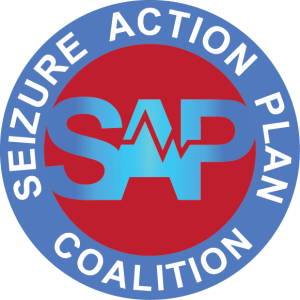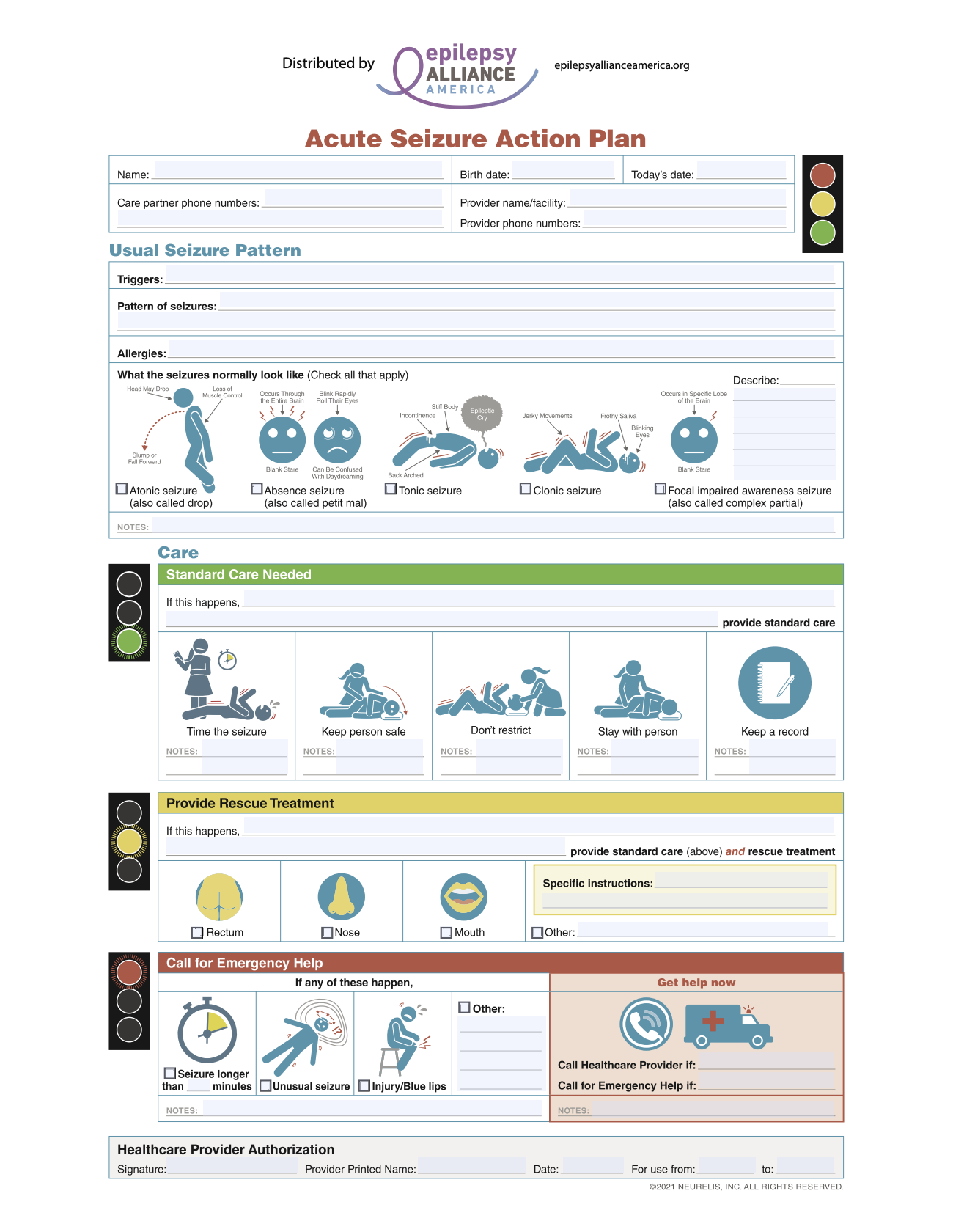
“Seizure Action Plans are meant to guide care in emergencies but are underused. Approximately 70% of persons with epilepsy do not have a Seizure Action Plan. This Seizure Action Plan includes simple to follow steps for seizure treatment and is designed to be used with a wide range of care partners including those with limited experience. By making it brief, concise, and easy to follow we hope that this will be not just a good guide but a useful tool for patients with epilepsy.”
– Lucretia Long, Epilepsy Alliance America National Program Advisory Committee member
What is a Seizure Action Plan (SAP)?
A seizure is a medical emergency. A Seizure Action Plan (SAP) contains tailored guidelines on how to respond during a seizure, based on the patient’s medical history. It includes health and medical information specific to the patient and helps others recognize seizures and the appropriate steps to take to keep him or her safe from injury or damage caused by prolonged seizures.
Seizure Action Plan - A Mother's Perspective
Amanda, Epilepsy Mom and Advocate, shares why she has a Seizure Action Plan for her son with epilepsy and the peace of mind it provides her. This video debuted during Seizure Action Plan Awareness Week 2023. It was created by Epilepsy Alliance America for the Seizure Action Plan Coalition.
What is a Seizure Action Plan?
Dr. Yash Shah shares the importance of a Seizure Action Plan and how to complete one. This video is a segment from the Back to School Seizure Preparedness webinar held on September 13, 2022. The webinar was produced by Epilepsy Alliance America and funding was provided by Neurelis, Inc.
Why I have a Seizure Action Plan: Dara
Dara was diagnosed with epilepsy at 35. She is the mother of four children. Hear in her own words WHY she has a Seizure Action Plan at home and at work. Learn how she gave each of her children a ‘job’ to do as part of her plan. Meet her co-worker who has had to jump into action when Dara had a seizure at work.
What is an Acute Seizure Action Plan?
An Acute Seizure Action Plan (ASAP) is a document that provides detailed health and medical information about an individual and their epilepsy or seizure disorder. The Acute Seizure Action Plan provides guidelines regarding how to respond when and individual is experiencing a seizure. This document will include input from the individual’s guardian, physician,
and/or neurology specialist.
Who uses it?
Every individual who interacts with an individual who has a seizure disorder will benefit from this information.
At school this includes teachers, nurses, coaches, and other individuals with supervisory roles should receive and review the SAP. The plan should also be shared with caregivers and babysitters and anyone else who anyone else who frequently interacts with the individual.
Where is it kept?
At school, typically the school nurse serves as the “gatekeeper” of the Acute Seizure Action Plan. It is advisable for a school nurse to have the ASAP in the student’s file, and the classroom teacher(s) should have a copy.
Parents and physicians should keep a copy as well.
Why is it necessary?
When your child has been diagnosed with epilepsy, you quickly learn when a seizure is a medical emergency. The information in this ASAP helps others to recognize your child’s seizures and determine when it’s an emergency. This prevents unnecessary 911 calls.
Who will benefit?
Everyone benefits from a ASAP. Students are more likely to receive an appropriate response, school teachers and school nurses have the necessary information to respond and provide first aid, and parents are more at ease knowing that a written plan is in place.
Is there a cost involved?
No, an Acute Seizure Action Plan is free provided that the student has access to, and visits, a physician treating their seizure disorder. The only cost involved is related to the time it takes to write and read the document.
How often is it updated?
It will depend on the needs of each student and changes in his/her medical condition. Most students will have the ASAP for the entire school year and maybe as long as they attend a given school. Students with more complex conditions may have their plan updated more frequently by their physician or medical specialist.
For more information about developing YOUR Seizure Action Plan, visit Time to Talk About Seizures and Rescue Therapies.
About the Acute Seizure Action Plan distributed by Epilepsy Alliance America
For complete information about the design of this Acute Seizure Action Plan please see Recommendations for Development of Acute Seizure Action Plans (ASAPs) From an Expert Panel, Lucretia Long, a member of the National Program Advisory Committee (NPAC) of Epilepsy Alliance America was part of the collaborating team
Special thanks to Epilepsy Services New Jersey for translating the Acute Seizure Action Plan to Spanish.


